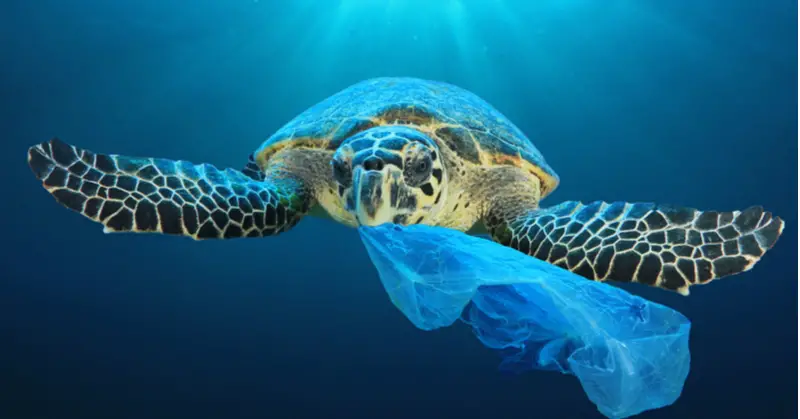It has long been said that sea turtles eat plastic bags because they look like jellyfish. Matthew Savoca, a doctoral student in Ecology at the University of California Davis, wasn’t content to accept this as the only reason. Surely there was more to it. He devoted his dissertation research to understanding why marine animals confused plastic waste for food.
Savoca was awarded the 2018 Science & SciLifeLab Prize for Young Scientists in Ecology and the Environment for his discovery that biofilms (composed of microbes, algae, plants and very small animals) gather on plastic in the marine environment and then give off an odor that tricks marine animals into thinking the plastic is actually food. 1 In the case of Green Sea Turtles, whose diets consist of seagrasses and algae, 2 plastics coated in algal biofilms end up being the perfect and tragic “olfactory trap” as Savoca calls it.1, 3
In other words: If you’ve ever handled a slimy nylon rope that’s spent time in the water at a seaside dock, it’s not hard to imagine how a plastic bag submerged in the ocean, slowly becoming coated in algae, might seem like yummy seagrass to a sea turtle.
Here is how Savoca summarized his award-winning research: “Plastics are a ubiquitous form of marine litter. Despite burgeoning scientific interest on the interactions between plastic waste and marine wildlife, far less research has focused on the behavioral mechanisms underlying the maladaptive decision to ingest plastic. This essay reveals that algal biofilms that coat marine plastics emit an odoriferous compound that many marine predators interpret as an indicator of productive foraging regions, suggesting that marine plastics may falsely amplify an olfactory signal that certain species associate with foraging opportunities.” 1
In the video below from the Australian Academy of Science, Dr. Denise Hardesty explains that it is estimated that over half of the world’s sea turtles have ingested plastic and “a turtle that has ingested one piece of plastic has a 20% chance of dying. After eating 14 pieces of plastic, there is a 50% chance of death.”4
Savoca’s most recently published research appears in Cell Press.5 That journal published a press release about the paper that provides a nice lay summary of the experimental design: “the researchers enlisted 15 young, captive-reared loggerhead turtles. They delivered a series of airborne odorants through a pipe in an experimental arena and recorded their reactions on video. The odors they tested included deionized water and clean plastic as controls along with the turtle’s food, which contains fish and shrimp meal and biofouled plastic.”6
One of Savoca’s co-authors, Joseph Pfaller of the University of Florida Gainesville, stated that the team was “surprised that sea turtles responded to odors from biofouled plastic with the same intensity as their food.”6
The team’s work adds important information as the research community considers ways to discourage marine animals from consuming plastic. We can all do our part by eliminating plastic packaging wherever possible and being sure to recycle whenever we can.
About the Prize: The Science & SciLifeLab Prize for Young Scientists is a collaboration of Science (the journal of the American Association for the Advancement of Science) and SciLifeLab (a Swedish national center for molecular biosciences. Founded on the premise that “global economic health is dependent upon a vibrant research community, each year, four young scientists are selected for work considered especially deserving of extra encouragement as the researchers begin their careers.”7
Sources
1SciLifeLab. 2018 Young Scientist Prize Winners. Matthew Savoca Biography & Synopsis.
2Maritime Aquarium at Norwalk. Meet the Animals: Green Sea Turtle.
3Savoca M. The ecology of an olfactory trap. Science. 2018;362(6417):904.
4VIDEO: Australian Academy of Science. Turtles and Plastic Pollution. 13 September 2018.
5Pfaller JB, Goforth KM, Gil MA, Savoca MS, Lohmann KJ. Odors from marine plastic debris elicit foraging behavior in sea turtles. Current Biology. 2020;30(5):R213–R214.
6Cell Press. “Sea turtles have a deadly attraction to stinky plastic.” ScienceDaily, 9 March 2020.
7Science. The Science & SciLifeLab Prize for Young Scientists.
—
R.A. Kroft writes about her day-to-day journey in living a smaller, more sustainable life and other topics that interest her.

This Site Was Inspired By An Interest in Protecting the Environment:
We had the privilege and joy of learning from Dr. Charlie Stine who instilled a love for the natural world through incredible field trips with the Johns Hopkins Odyssey Certificate program in Environmental Studies. At the time, the program was endorsed by the Maryland Department of Natural Resources. Sadly, after Dr. Stine retired, the program was phased out. We hope that we honor his legacy by shining a bright light on environmental issues and sharing good news about the success of various conservation programs when possible.


